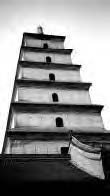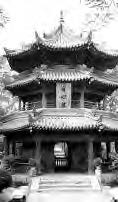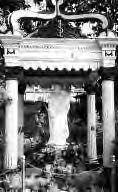The Silk Roads, an incurably romantic subject which offers a splendid source for secondary school teachers and students alike, linked the civilizations of Eurasia for much of premodern history, starting as early as the second century, B.C.E., if not earlier. China, Central Asia, West Asia, and, to a lesser extent, Europe, were placed in touch with each other via the Silk Roads. The economic significance of their contacts in pre–1500 history may have been exaggerated, but their cultural impact can hardly be overstated, and the political influences, particularly during the era of the Mongol empire, have only, of late, received much attention.
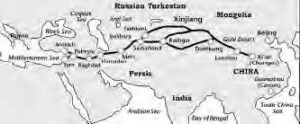
Major themes of cultural borrowing, interactions of civilizations, and the development of new economic institutions and technologies to facilitate commerce, together with the sheer excitement of travel and adventure, can be conveyed through historical descriptions of the Silk Roads. East and West Asian civilizations that have often received short shrift in the secondary school curriculum can be brought to life through study of the history of the Silk Roads. Even nineteenth and twentieth-century relations between Asia and Europe, when the Silk Roads appear to have lost much of their significance, can be profitably analyzed through examination of clashes of interests along these old East-West caravan routes.
A good pedagogical device in teaching about the Silk Roads is to focus on specific individuals or occasionally composites—travelers, merchants, missionaries, adventurers, entertainers, and others—who embody the central historical themes. Teachers are blessed with a panoply of fascinating figures who played roles in the long history of the Silk Roads. More fortuitous still, quite a number either wrote accounts of their travels or were themselves the leading figures of contemporaneous histories, diaries, or biographies. Primary sources, often laced with excitement, humor, and insights, thus can constitute the core of a unit on the Silk Roads. The teacher naturally may need to select and edit these accounts to eliminate unfamiliar names of persons or places or irrelevant recital of events that might encumber or deflect the students’ interest.
Growing scholarly and pedagogical concern for global history has resulted in the writing of secondary studies of great value to teachers seeking to impart educational themes related to the Silk Roads. Jerry Bentley’s Old World Encounters, with its emphasis on cultural relations and interactions, offers compact surveys of religious and technological diffusion, while Philip Curtin’s Cross-Cultural Trade in World History focuses on commerce, with descriptions of trade in specific commodities. S. M. Adshead’s Central Asia in World History demonstrates the significance of that relatively unstudied region, which travelers and caravans needed to traverse, and my own “The ‘Decline’ of the Central Asian Caravan Trade” analyzes the essential conditions for the proper operation of the Silk Roads. In Plagues and Peoples, William McNeill describes the diffusion of diseases both via the Silk Roads and seaborne commerce. Though Janet Abu-Lughod’s Before European Hegemony makes a compelling argument for the importance of the Silk Roads trade, it is marred by factual errors and must be used with care. All these works are available in paperback editions and are thus accessible to teachers who seek additional information.
Silk Roads history may be conveniently, if somewhat artificially, divided into four periods. Teachers may not wish to be bound to this scheme, but it offers a useful means of describing the ebbs and flows of this link between the East and the West. The first period lasted from around the second century, B.C.E. to the second century, C.E., the era of the initial development of the various Silk Roads and the establishment of the oases and towns which connected the Han dynasty (206 B.C.E.–C.E. 220) of China with Central Asia and West Asia. The collapse of the Han and of the Parthian Empire of Persia diminished commerce and travel along the East-West trade routes. The second period stretched from the seventh to the late ninth century, the time of the cosmopolitan Tang dynasty of China and of the expansion of Islam from the Arab world through Persia to Central Asia. The gradual decline and downfall of the Tang in the late ninth and early tenth centuries and the growing turbulence in Central Asia resulted in virtual cessation or at least dramatic reduction of commerce on the Silk Roads.
The third period, which encompassed the thirteenth and fourteenth centuries, coincided with the rise and expansion of the Mongol empire, whose leaders favored trade and whose conquests led to a Pax Mongolica over much of the traditional Silk Roads, facilitating trade and travel along many of these routes. The disintegration of the Mongol Khanates, together with the discovery of the sea routes from Europe to Asia in the late fifteenth century, disrupted the Silk Roads trade and led to decline in parts of Central Asia. Ocean-borne commerce superseded overland trade on the Silk Roads.
The fourth period, which spans the late nineteenth century to the present, started with the Tsarist Russian expansion into Central Asia in the 1850s and 1860s and with the explorations and other activities of Western and Japanese scientists, adventurers, and scholars in the region in the late nineteenth and early twentieth centuries. It then continued into Nationalist Chinese, Tsarist Russian, Japanese, USSR, and Chinese Communist rivalry and domination in Central Asia, the indigenous ethnic and religious revival in response to such foreign control, and the establishment of independent countries in the area in the late 1980s and early 1990s. The Silk Roads may at present witness a resurgence, but they must now be referred to as the Oil and Gas Roads, as Azerbaijan, Kazakhstan, Turkmenistan, and perhaps Mongolia gush forth with the new gold of petroleum, a resource which offers the region greater significance in the modern world.
Study of the Silk Roads offers opportunities to consider major themes in Asian history—the significance of trade, the spread of religions, the diffusion of technologies and artistic motifs, and the development of powerful military forces and empires. Yet perhaps even more appealing for students is the cast of characters directly involved in Silk Roads history. Teachers will certainly wish to select their own casts, but a brief description of figures in each of the four periods designated earlier may prove useful. One caveat: four of the following eight are real figures, and the rest are composites, though the latter reflect the activities and times of attested individuals who traveled along the Silk Roads but who did not leave written accounts.
BEGINNINGS OF THE SILK ROADS
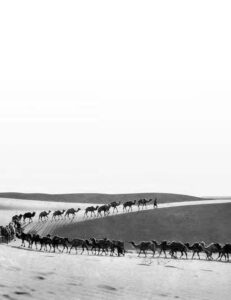
Photographer: Harold Loucks
Setting the stage for the first period is a Princess of the Han dynasty (206 B.C.E.–C.E. 220) sent to marry the Shanyu or ruler of a pastoral nomadic people known in the Chinese sources as the Xiongnu who tended their animals in the area of modern Mongolia and southern Siberia. This group, which needed trade with China, became increasingly bellicose when denied such commerce. Ecological crises also could have prompted them to raid Chinese settlements to obtain the goods they required. The Han, which professed to be economically self-sufficient, tried to limit commercial and diplomatic relations with these peoples, whom they perceived as “barbarians.” Yet awareness of the threat posed by the Xiongnu cavalry and armies compelled the Chinese dynasty to seek peace. One of their tactics was marital alliances, and thus the dispatch of the Princess.
The story of the Princess may be used to illustrate Chinese attitudes towards foreigners as well as the differences between sedentary agricultural civilizations and nomadic pastoral societies, differences that would have a dramatic impact on the Silk Roads trade. The elaborate philosophical systems, the well-planned capital cities, the carefully devised hierarchical and social structures, the luxury products (jade, silks, etc.), and the sophisticated cuisines of the sedentary civilizations can be contrasted to the animal-centered economy, the more independent and mobile lifestyle, and the less luxurious and more precarious existence of the pastoral nomadic societies. The Princess’ initial distaste for her new, rougher surroundings and her eventual accommodation and even admiration for the tribal society into which she was adopted offer useful illustrations of tolerance for and adjustment toward other styles of life.
Marital alliances aside, the Han-Xiongnu relationship remained fraught with conflict, partly because the Chinese denied badly needed trade to the pastoral nomads. Simultaneously, economic difficulties, on occasion, compelled the Xiongnu to raid Chinese border settlements. Deciding to seek assistance against its bellicose neighbors, around 139 B.C.E. the Han sent Zhang Qian, the second of our Silk Roads figures, to Central Asia to forge such an alliance. Zhang traveled through the oases and towns that would eventually constitute the Silk Roads and reached Central Asia but was rebuffed in his efforts to secure allies. Nonetheless, his mission promoted trade because he described the coveted “bloodsweating” horses of Central Asia to the Han court and brought silk to the wider attention of the peoples residing west of China. Thus demand for Chinese silk increased in Central and West Asia, leading to the development of the first epoch in the Silk Roads trade.
Not only would the story of Zhang Qian be absorbing to students, but they could also, through reading accounts about Zhang and other early travelers, recognize the complexities entailed in the proper operation of the Silk Roads trade, which required (1) a string of oases and towns offering shelter, food, and water to travelers; (2) guard stations to warn merchants of dangers en route; (3) interpreters and translators; (4) guides and camel grooms; (5) capital to fund the caravans; (6) written or oral descriptions of the routes; and (7) stable governments in at least China and Persia to keep the caravans free of bandit harassment. These conditions persisted for several centuries or until the collapse of the Han. Without a central government in China, commerce along the Silk Roads steadily diminished.
HEIGHT OF THE SILK ROADS TRADE
However, cultural contacts among civilizations, via the Silk Roads, endured, and Xuanzang, the third of our figures, reflects such continued relations. Facing a fragmented and politically unstable world, the post-Han Chinese sought solace in Buddhism, a religion that reached China from India along the Silk Roads oases and towns. Seeking greater understanding of Buddhism, Chinese monks traveled to India. Xuanzang, the most renowned of these Chinese Buddhist monks, journeyed to India in the seventh century to study with Buddhist masters, visit important religious sites, and gather Buddhist texts and artifacts. His travel account and his adventures provide teachers with a lively means of explaining Buddhist principles as well as showing Buddhist art and ritual objects.
Xuanzang’s voyage ushered in a flourishing era in the history of the Silk Roads. The Tang dynasty (618–907) of China welcomed foreigners and foreign trade. A Persian merchant and a Central Asian dancer, the next two of our figures, represent the travelers of this time. The Persian merchant, a Muslim, can be used to indicate the rapid spread of such religions as Islam, Zoroastrianism, and Nestorianism throughout Asia along the Silk Roads. Accounts based on the travels of such traders yield descriptions of the lively bazaars in the Central Asian towns and in the great Chinese capital of Changan, of the products exchanged, and of the conditions of commerce. The instructor can use the Central Asian dancer, who can be visualized through the Tang tricolored ceramic figurines of foreign entertainers (examples of which may be found in almost any U.S. museum with a significant collection of Chinese art), to reveal cultural diffusion—in this case, of music and dance—and to show activities at the court.
MONGOL HEGEMONY
After the fall of the Tang, trade along the Silk Roads declined, and it revived only with the rise of the Mongols. During this time, China was a “lesser empire” and could neither dominate the nearby oases and towns nor protect caravans heading westward. In the thirteenth century, the Mongols erupted from Mongolia and created the largest contiguous land empire in world history. They conquered and ruled much of the territory through which the Silk Roads traversed and encouraged the greatest flow of merchants, craftsmen, and missionaries across Eurasia until that time.
Marco Polo, the next of our figures and arguably the most renowned traveler ever, was one of these merchants, and his account, which was actually written by the storyteller Rusticello, provides
teachers with lively and colorful anecdotes with which to describe and address such themes as: (1) the organization of empires; (2) Mongol military structure and strategy; (3) the status of women in nomadic pastoral societies; (4) technological diffusion; (5) toleration of the religions of subjugated peoples as a tactic for governance; and (6) the Mongol invasions as a possible source of the Black Death. Errors of commission and omission in Marco Polo’s work have spurred some to question whether he actually reached China, a subject that could also stimulate lively discussion in the classroom.
The collapse of the Mongol empire and the late fifteenth-century discovery of the sea route from Europe to Asia led to a precipitous decline of the Silk Roads trade in Central Asia, the crossroads for this commerce, until the late nineteenth century. The flourishing oases and towns sank into poverty, and nomadic empires, such as the Xiongnu and the Mongol, could no longer match the advanced military technology (guns, rifles, cannons, etc.) and the growing populations of the neighboring civilizations. In fact, in the seventeenth and eighteenth centuries, Qing China and Tsarist Russia gained control over these regions and ruled what was by then a mostly Turkic Muslim population. Central Asia and the Silk Roads seemed to disappear from the historical stage.
SILK ROADS IN MODERN TIMES
The late nineteenth-century scramble for colonies in Asia revived interest in Central Asia and the Silk Roads region. Great Britain and Russia were the first to compete for influence in the zone in a struggle referred to as the Great Game. Later, Japan joined in the competition. Diplomats and soldiers were not the only participants; scientists, geographers, adventurers, and archeologists were lured by the treasures of the Silk Roads.
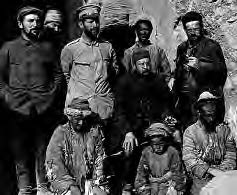
Albert Von Le Coq (1860–1930), our next protagonist, was an amateur explorer and archaeologist who was drawn to the art and artifacts of the region. He gathered precious manuscripts and chipped out Buddhist and Manichaean cave paintings in Bezeklik and Kharakhojo and sent them to the Ethnological Museum in Berlin, justifying what appeared to be theft by asserting that he was saving these works from defacement and vandalism. Ironically, the Allied bombing of Berlin in World War II destroyed much of his collection. Von Le Coq’s story lends itself to provocative classroom discussion of the ethics of the late nineteenth-century archaeologists and, for that matter, twentieth-century museum curators from the so-called developed world who have either spirited out or purchased works of art, regarded by some native peoples as part of the national patrimony, from so-called underdeveloped countries.
One twentieth-century reaction to such foreign cultural hegemony and political domination has been an explosive rise of nationalism among the previously subjugated peoples who resided along the Silk Roads. The five Central Asian states of Uzbekistan, Turkmenistan, Tajikistan, Kazakhstan, and Kirghizstan, which had been ruled by Russia and later by the USSR, each declared independence in the early 1990s. Simultaneously, Mongolia broke away from Soviet overlordship. Stirrings of discontent have appeared in the Chinese-dominated lands of Xinjiang (with its largely Turkic population), Tibet, and Inner Mongolia, but the People’s Republic of China has managed, by alternate use of force and persuasion, to retain control.
Our final protagonist, an Uyghur nationalist from Xinjiang, could embody the recent transformations in the region. Born in 1960, this man’s early education was disrupted by the Chinese Cultural Revolution (1966–early 1970s) when his school was closed and by the government’s mandating use of the Chinese language in Xinjiang. Repressive measures against Islam during this period prevented him from observing his faith. However, the liberalization after the Cultural Revolution benefited the young Uyghur because the government wished to portray itself as a protector of the ethnic minorities within China. It reopened mosques and permitted the reprinting of The Koran.
Our protagonist capitalized on the new policies to gain admission to university to study the history and archaeology of Xinjiang and eventually, after graduation, to take part in several excavations in his native region. Paradoxically, with success came his awareness that the Chinese occupied the leading positions in government and the economy in Xinjiang. He joined an underground nationalist movement which sought greater autonomy or independence from China and participated in demonstrations in Urumchi, the capital of Xinjiang, during the Tiananmen protest movement in 1989. Despite the government’s suppression of the movement in Tiananmen and other locations throughout China, he persists to the present in his efforts to achieve greater independence for the Uyghurs.
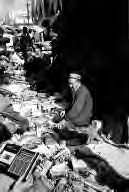
The growing economic significance of the old Silk Roads gives him confidence for the future. The oil and gas discovered in Azerbaijan, Kazakhstan, Turkmenistan, and Mongolia have inspired visions of a revival of the Silk Roads in the form of oil pipelines and of a resurgence of trade throughout the region, potentially offering great economic leverage to him and his people.
The Silk Roads, from their inception to the present, provide the teacher with an ideal vehicle to introduce students to Asian cultures. Political history, economic institutions, art, religions, technology, and geography all can be discussed courtesy of the Silk Roads, and many Asian civilizations can be interrelated through this glorious and colorful vehicle.
SOURCES FOR TEACHERS
I. GENERAL
Good maps, bibliographies, and photographs and descriptions of the art and artifacts produced or traded along the Silk Roads may be found in the catalogs for three Silk Roads exhibitions:
Anne Wardwell and James Watt, with an essay by Morris Rossabi, When Silk Was Gold (New York: Abrams, 1997); John Vollmer, et al., Silk Roads, China Ships (Toronto: Royal Ontario Museum, 1983); and Along the Ancient Silk Routes (New York: Berlin State Museum and Metropolitan Museum of Art, 1982). NHK, Japan Broadcasting Corporation (1177 Avenue of the Americas, New York, New York 10036) has produced 12 fifty-minute videos entitled “The Silk Road: An Ancient World of Adventure.” The Department of Education at The Asia Society (725 Park Avenue, New York, New York 10021) is currently producing a prototype for a CD-ROM on the Silk Roads (available in spring of 1999). The American Forum for Global Education (120 Wall Street, New York, New York 10005) is developing curriculum materials for Central/Inner Asia: Connections and Cultures (available in summer of 1999), which will incorporate a lengthy section on the Silk Roads. A useful Web site with links to numerous other sites is www.silkroad.com.
II. SPECIFIC ERAS
On Xiongnu-Chinese interactions, see Sechin Jagchid and Van Jay Symons, Peace, War, and Trade Along the Great Wall (Bloomington: Indiana University Press, 1989); Yu Ying-shih, Trade and Expansion in Han China (Berkeley: University of California Press, 1967); and Thomas Barfield, The Perilous Frontier (Oxford: Blackwell Publishers, 1989). On nomads in general, see Anatoly Khazanov, Nomads and the Outside World (Madison: University of Wisconsin Press, 1994, 2nd ed.). A primary source for Zhang Qian has been translated in Burton Watson, Records of the Grand Historian of China (New York: Columbia University Press, 1961) vol. 2, 264–274. One useful secondary account is Jeannette Mirsky, The Great Chinese Travelers (Chicago: University of Chicago Press, 1964), 13–25.
Sally Wriggins has written a readable book on Xuanzang entitled Xuanzang: A Buddhist Pilgrim on the Silk Road (Boulder: Westview Press, 1996). The great Chinese novel translated as Journey to the West (Chicago: University of Chicago Press, 1977–1983, 4 vols.) by Anthony Yu offers a fictional portrait (along with much else) of the Buddhist pilgrim. Art Treasures of Dunhuang (Hong Kong: Joint Publishing Company, 1981) is one among many works with splendid plates of the Buddhist art that Xuanzang might have seen on his travels. Also useful is Liu Xinju, Silk and Religion (Delhi: Oxford University Press, 1996).
For visual representations of the Persian merchant and the Central Asian dancer, see Ezekiel Schloss, Foreigners in Ancient Chinese Art (New York: China Institute, 1969) and Jane G. Mahler, The Westerners Among the Figurines of the T’ang Dynasty of China (Rome: Istituto Italiano per il Medio ed Estremo Oriente, 1959). Morris Rossabi, “China and the Islamic World” in Bernard Lewis and Edmund Leites, eds., As Others See Us: Mutual Perceptions, East and West (New York: International Society for the Comparative Study of Civilizations, 1985) provides background for the role of Islam on the Silk Roads, and Edward Schafer, The Golden Peaches of Samarkand (Berkeley: University of California Press, 1963) offers a wealth of information on the products, the people, and the cultures of the Silk Roads during Tang times.
For sources (including translations of his work, novels, films, and plays) on Marco Polo, see Morris Rossabi, Khubilai Khan: His Life and Times (Berkeley: University of California Press, 1988), 261–262, footnote 170. Frances Wood, Did Marco Polo Go to China? (Boulder: Westview Press, 1996) argues that Marco Polo never reached China. On the Mongols, see David Morgan, The Mongols (Oxford: Blackwell Publishers, 1986). The A & E television network (235 East 45 Street, New York, New York 10017) has produced Marco Polo and Genghis Khan, two 50-minute videos, for its Biography series.
Peter Hopkirk, Foreign Devils on the Silk Road (London: John Murray, 1980) is a highly readable account of the works of Von Le Coq and other adventurers on the Silk Roads in the late nineteenth and early twentieth centuries. A personal view of developments among the Uyghurs at present is Justin Rudelson, Oasis Identities: Uyghur Nationalism Along China’s Silk Road (New York: Columbia University Press, 1997). Latest developments along the contemporary Silk Roads can be followed in the www.soros.org Web site; its Central Eurasia Project provides information on the latest news, international involvement, and cultures of Georgia, Azerbaijan, Uzbekistan, Armenia, Mongolia, Tajikistan, and Kyrgyzstan.
SECONDARY SOURCES
Abu-Lughod, Janet. Before European Hegemony. New York: Oxford University Press, 1989.
Adshead, S. M. Central Asia in World History. New York: St. Martin’s Press, 1993.
Bentley, Jerry. Old World Encounters. New York: Oxford University Press, 1993.
Curtin, Philip. Cross-Cultural Trade in World History. Cambridge: Cambridge University Press, 1984.
McNeill, William. Plagues and Peoples. New York: Doubleday Anchor, 1977.
Rossabi, Morris. “The ‘Decline’ of the Central Asian Caravan Trade” in James Tracy, ed., The Rise of Merchant Empires. Cambridge: Cambridge University Press, 1990.


